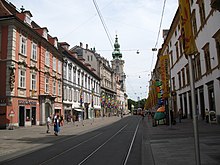Herrengasse (Graz)
Herrengasse , in the Middle Ages Bürgerstrasse, also Bürgergasse , is the name of a baroque boulevard in the center of Graz and a focal point of public life in the Styrian capital. It connects the main square with the Am Eisernen Tor square , near Jakominiplatz, the center of public transport in Graz. It runs approximately in a north-south direction parallel to the Mur on the left side of the Mur . All Graz tram lines run through Herrengasse, which has been largely a pedestrian zone since November 1972 and is therefore closed to individual traffic.
history
The area of today's Herrengasse is an old settlement area, where finds were also made from the Hallstatt period. At the southern end of Herrengasse (roughly in the area of today's Mesnergasse) was the walled Jewish ghetto mentioned in 1261. Between 1457 and 1475, the Bürgerstrasse , where the most respected Graz citizens lived, was renamed Herrengasse , as more and more of the aristocrats were buying property here.
Rampage 2015
On June 20, 2015, a man with his SUV killed three people and injured dozen other people in a rampage in Herrengasse.
List of important buildings
(Numbering according to house numbers, even on the right, odd on the left starting from the main square)
- 1 - Salzburger Hof
- 2 - Schranne , the place of jurisdiction until the beginning of the 16th century, then town hall
- 3 - ducal feudal court, " Painted House " (imperial residence)
- 9 - Palais Breuner with a Roman pillar base
- 10 - Caspar Antoni Forno's coffeehouse (1747); Demolished in 1887 and built into the new town hall
- 13 - Stubenberg's house ; Napoleon Bonaparte's quarters in Graz (April 1797)
- 15 - the old main customs office building
- 16 - country house , first Renaissance building of the city of Graz and state armory
- 17 - Steiermärkischen Escomptebank (1910), neo-baroque building (No. 15–17), today CA
- 23 - parish church "Zum heiligen Blut"; Access to the monastery cloister
- 28 - Thonethof ; formerly kk military town command, in front of that the brewery of the trader Aegydius Gunzinger (around 1648)
Individual evidence
- ^ Fritz Popelka: History of the City of Graz. 1st volume, self-published by the City of Graz, Graz 1928
literature
- Walter Brunner on behalf of the City of Graz, Cultural Office (Ed.): History of the City of Graz. 4 volumes, self-published by the city of Graz 2003, ISBN 3-902234-02-4



